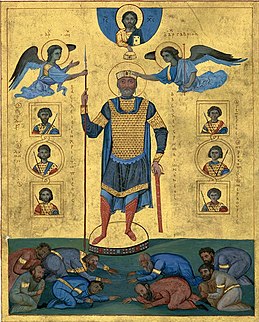 | |
| This article is part of the series on the military of the Byzantine Empire, 330–1453 AD | |
| Structural history | |
|---|---|
| Byzantine army: East Roman army, Middle Byzantine army (themes • tagmata • Hetaireia), Komnenian-era army (pronoia), Palaiologan-era army (allagia) • Varangian Guard • Generals (Magister militum • Domestic of the Schools • Grand Domestic • Stratopedarches • Protostrator) | |
| Byzantine navy: Greek fire • Dromon • Admirals (Droungarios of the Fleet • Megas doux) | |
| Campaign history | |
| Lists of wars, revolts and civil wars, and battles | |
| Strategy and tactics | |
| Tactics • Siege warfare • Military manuals • Fortifications (Walls of Constantinople) | |
The Paramonai (Greek : Παραμοναί) were an obscure Byzantine guard regiment of the Palaiologan period.

Greek is an independent branch of the Indo-European family of languages, native to Greece, Cyprus and other parts of the Eastern Mediterranean and the Black Sea. It has the longest documented history of any living Indo-European language, spanning more than 3000 years of written records. Its writing system has been the Greek alphabet for the major part of its history; other systems, such as Linear B and the Cypriot syllabary, were used previously. The alphabet arose from the Phoenician script and was in turn the basis of the Latin, Cyrillic, Armenian, Coptic, Gothic, and many other writing systems.

The Byzantine Empire, also referred to as the Eastern Roman Empire or Byzantium, was the continuation of the Roman Empire in its eastern provinces during Late Antiquity and the Middle Ages, when its capital city was Constantinople. It survived the fragmentation and fall of the Western Roman Empire in the 5th century AD and continued to exist for an additional thousand years until it fell to the Ottoman Turks in 1453. During most of its existence, the empire was the most powerful economic, cultural, and military force in Europe. Both the terms "Byzantine Empire" and "Eastern Roman Empire" are historiographical terms created after the end of the realm; its citizens continued to refer to their empire simply as the Roman Empire, or Romania (Ῥωμανία), and to themselves as "Romans".
The name derives from the Greek verb παραμένω, meaning "to stand near something". Unlike other major guard units in the Palaiologan army like the Varangian Guard, the regiment of the Paramonai was a native Byzantine formation, although little else is known about it. Its existence is safely attested in the literary sources only for the period from 1272 until 1315. [1]

The Varangian Guard was an elite unit of the Byzantine Army from the tenth to the fourteenth century, whose members served as personal bodyguards to the Byzantine Emperors. The Varangian Guard was known for being primarily composed of recruits from northern Europe, including Norsemen from Scandinavia and Anglo-Saxons from England. The recruitment of distant foreigners from outside Byzantium to serve as the emperor's personal guard was pursued as a deliberate policy, as they lacked local political loyalties and could be counted upon to suppress revolts by disloyal Byzantine factions.

The Byzantine Greeks were the Greek-speaking Christian Romans of Late Antiquity and the Middle Ages. They were the main inhabitants of the lands of the Byzantine Empire, of Constantinople and Asia Minor, the Greek islands, Cyprus, and portions of the southern Balkans, and formed large minorities, or pluralities, in the coastal urban centres of the Levant and northern Egypt. Throughout their history, the Byzantine Greeks self-identified as Romans, but are referred to as "Byzantine Greeks" in modern historiography.
They are still mentioned by the mid-14th century writer Pseudo-Kodinos, however, who records that the regiment had two divisions, one on foot and the other on horse, each commanded by an allagator , and that all the soldiers were armed with swords. The veracity of Kodinos's account is impossible to ascertain. [1]

The allagion was a Byzantine military term designating a military unit. It first appeared in the mid-to-late 10th century, and by the 13th century had become the most frequent term used for the Byzantine army's standing regiments, persisting until the late 14th century.
A sword is a bladed weapon intended for slashing or thrusting that is longer than a knife or dagger, consisting of a long blade attached to a hilt. The precise definition of the term varies with the historical epoch or the geographic region under consideration. The blade can be straight or curved. Thrusting swords have a pointed tip on the blade, and tend to be straighter; slashing swords have a sharpened cutting edge on one or both sides of the blade, and are more likely to be curved. Many swords are designed for both thrusting and slashing.





